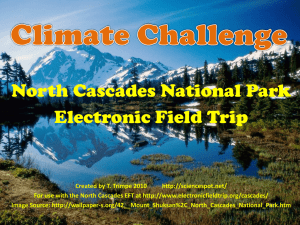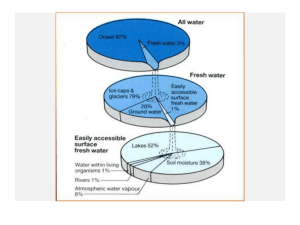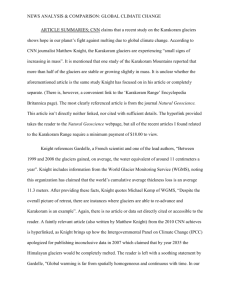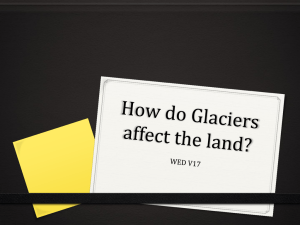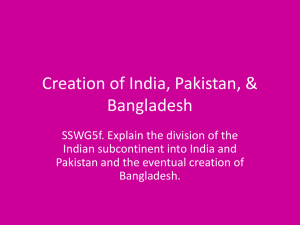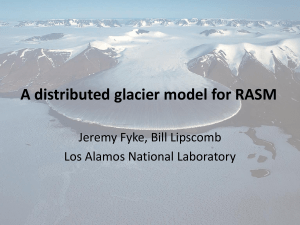Cryosphere of HKH region
advertisement
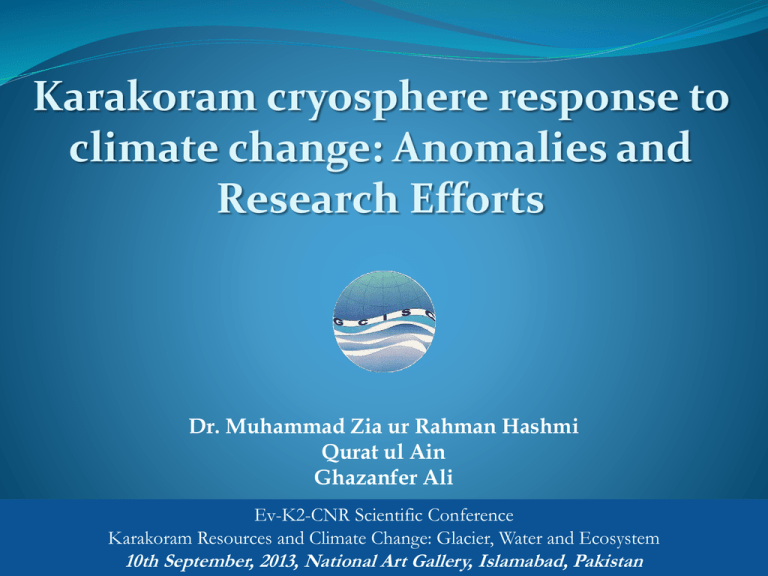
Karakoram cryosphere response to climate change: Anomalies and Research Efforts Dr. Muhammad Zia ur Rahman Hashmi Qurat ul Ain Ghazanfer Ali Ev-K2-CNR Scientific Conference Karakoram Resources and Climate Change: Glacier, Water and Ecosystem 10th September, 2013, National Art Gallery, Islamabad, Pakistan Outline Cryosphere of HKH region HKH Glaciers under changing climate The “Karakoram Anomaly” Research Activities under GCISC-EV-K2-CNR Collaboration Conclusions 2 Cryosphere of HKH region Upper Indus Basin (UIB) region 3 Some facts related to cryosphere of UIB • • • • Total Glacial Area…. Est. total Ice Reserves..……….. Total number of Glaciers……. Largest glacier area…. = 15061.74 sq.km = 2,174 Km3 = 11,413 = 925.93 Km2 Source: ICIMOD (2011) 4 Inman (2010) has noted, “According to a 2006 review by Cogley and others, the Himalayas are in the middle of the pack (“Himalayan glaciers are losing mass faster than European glaciers but slower than those in Alaska.”) Source: Inman (2010) 5 ...Cont HKH Glaciers under changing climate Source Finding World Glacier Monitoring Service Measurements taken over the last century clearly reveal a general shrinkage of mountain glaciers on a global scale Mason Inman (2010) In Nature reports-climate change “The remote glaciers of the Himalayan mountains have been a subject of much controversy, yet little research” (Out of about 12000 to 15000 glaciers in Himalaya and around 5000 in Karakorum, very few have been measured on the ground to see if they are losing or gaining mass) “It is pretty clear that Himalayan glaciers have been losing mass, with markedly greater loss in the past decade than earlier” Graham Cogley, Geographer, Trent University Ontario Out of 42 studied glaciers in Karakoram region, 58% advancing/stable and 42% retreating. In all other regions (Himalaya, Hindukush, West Kunlun Shan), the studied glaciers are mostly retreating. Study has found that the debris cover has a significant influence on glacier terminus dynamics. Dirk Scherler et al. (2011) In Nature Geoscience (Effect of Debris cover) 6 Karakoram cryosphere under changing climate “Karakoram Anomaly” Source Hewitt, 2005 Bishop et al., 2008 Hewitt, 2011 Copland et al., 2011 Dirk Scherler et al. (2011) Gardelle et al., 2012 Sarikaya et al., 2012 Kääb et al., 2012 Janes and Bush 2012 Wiltshire, 2013 Cogley (2012) in Nature Geoscience Finding Stable/slightly advancing glaciers “No ice lost in the Karakoram” 7 Analysis of Climate data supporting the slow response of Karakoram Glaciers to changing climate Source Finding Elisa Palazzi (ISAC CNR) et Analysis of last ~60 years of northern Pakistan al. (2013) data from Pakistan Met Deptt show; • Decreasing trend in JJAS minimum temperatures • Increasing trend in DJFMA maximum temperatures • Increasing trend in DJFMA precipitation Bocchiola and Diolaiuti (2013) (Italians) PMD’s “hill stations” monthly data for 1980– 2009 in the upper Karakoram, Northern Pakistan; “Slightly decreased Summer temperatures, and increased Winter Prec., possibly leading to increasing snow covered area at thaw” 8 Cliamte Change Research at GCISC GCISC Climatology Development of regional and Pakistan specific CC scenarios using RCMs (RegCM, Precis, WRF etc.) Water Resources and Glaciology Assessment of CC impacts on Pakistan water resources using RS/GIS techniques and hydrological models Agriculture Assessment of CC impacts on Pakistan’s agriculture using Crop simulation models Assist national planners and policymakers in strategic planning in the wake of Climate Change concern and raise public awareness 9 Major Collaborating International Partners • APN Asia Pacific Network for Global Change Research, Japan; • ASICTP Abdus Salam Int. Centre for Theoretical Physics, Italy; • IIASA Int. Inst. for Applied Systems Analysis, Austria; • NCAR National Centre for Atmospheric Research, USA; • GECAFS Global Environment Change and Food System, UK; • ICIMOD International Centre for Integrated Mountain Development, Nepal; • UNC University of Newcastle, UK • Ev-K2-CNR,Italy Recently signed an MoU 10 Research Activities under GCISC-EV-K2-CNR Collaboration 11 SUMMER FIELD CAMPAIGN ON GLACIOLOGICAL, HYDROLOGICAL AND ATMOSPHERIC MONITORING ACTIVITIES ON BALTORO GLACIER, KARAKORAM, PAKISTAN 2013 Objectives of the Activity • Assessment of current status of Karakorum Glaciers under changing climate by carrying out GLACIOLOGICAL, HYDROLOGICAL AND ATMOSPHERIC MONITORING in Baltoro glacier, that includes; • Glacier snout positions measurement • Stakes measurements (position and coordinates) of previously installed stakes (year 2011) at different position along with Baltoro glacier • Installation and maintenance of stakes up to Concordia • Snow pit measurements (snow depth profile, temperature and density measurement of different layers of snow) • Radar profile measurements to evaluate the ice depth in Baltoro glacier region. Field Team Scientific expedition was consisting of total 10 members from Europe and 1. 2. 3. 4. 5. 6. 7. 1. 2. 3. Pakistan. European Participants: Chris Mayer (Group Leader, German) Astrid Lambrecht (Researcher, German) Umberto Minnora (PhD Student, Milano University, Italian) Luigi Bonetti (Researcher, Italian) Roberto Ambrosini (PhD Student, Italian) Daniele Bernasconi (Italian Guide) Stepheno (Generalist, Italian) Pakistani (GCISC) Participants: Ms. Qurat ul Ain Ahmad (Scientific Officer, GCISC) Mr. Shahbaz Mehmood (Scientific Officer, GCISC) Mr. Muhammad Amjad (Scientific Officer, GCISC) Benefits of the Activity • Capacity building of GCISC scientists in; • Stake drilling, monitoring and maintenance procedure • Snow depth profile for measuring temperature and density of different snow layers • (The most difficult) First step towards long lasting Research Collaboration between GCISC and Ev-K2-CNR scientists Glimpses of some Field Activities Snow pit measurement pH measurement Stake drilling procedure The Alpine Summer School 2013 The Alpine Summer School was arranged by Institute of Atmospheric Sciences and Climate of the National Research Council (ISAC CNR), Italy, in collaboration with EV-K2-CNR, at Valsavarenche, Aosta valley, Italy The participants came from all over the globe including Pakistan (GCISC), India, Nepal, Canada, America, France, Italy, Denmark, Malaysia, Turkey, Israel, and Philistine The School consisted of; A series of lectures/seminars Field Expedition/Hiking 19 Lectures on following main Themes; Theme 1: Atmospheric dynamics in mountain regions Theme 2: Hydrological cycle in the mountains Theme 3: Ecosystems and biodiversity Theme 4: Past climate variations in mountain regions Theme 5: Climate modelling in mountain regions Current activities of WR&G section of GCISC Statistical downscaling of meteorological data for use in hydrologic studies using Weather generators and Regression-based techniques Analysis of extreme hydro-meteorological events under changing climate Assessing future flows in UIB under different SRES scenarios using downscaled data in hydrological models to investigate; Water availability in the near future (first few decades) and far future Changes in the Intra-Annual pattern of river flows Uncertainties Assessing CC impacts on mangrove forests in the Indus Basin delta Frequency of GLOF events and vulnerability of communities living up in the Northern region of Pakistan 21 Conclusions Climate change has serious implications for Pakistan’s water resources due to dependence on glaciers Need for exploring new dimensions of research apart from glacier mass balance studies to assess climate change impacts on Karakoram cryosphere GCISC has an important role in building country’s resilience against climate change but lacks data as well as technical capacity in some areas e.g. Glacier mass balance studies for Pakistan through field measurements and use of advanced RS/GIS tools and techniques Advanced glacio-hydrological modelling “No matter what accomplishments you make, somebody helped you.” —Althea Gibson 22 Thank you 23
